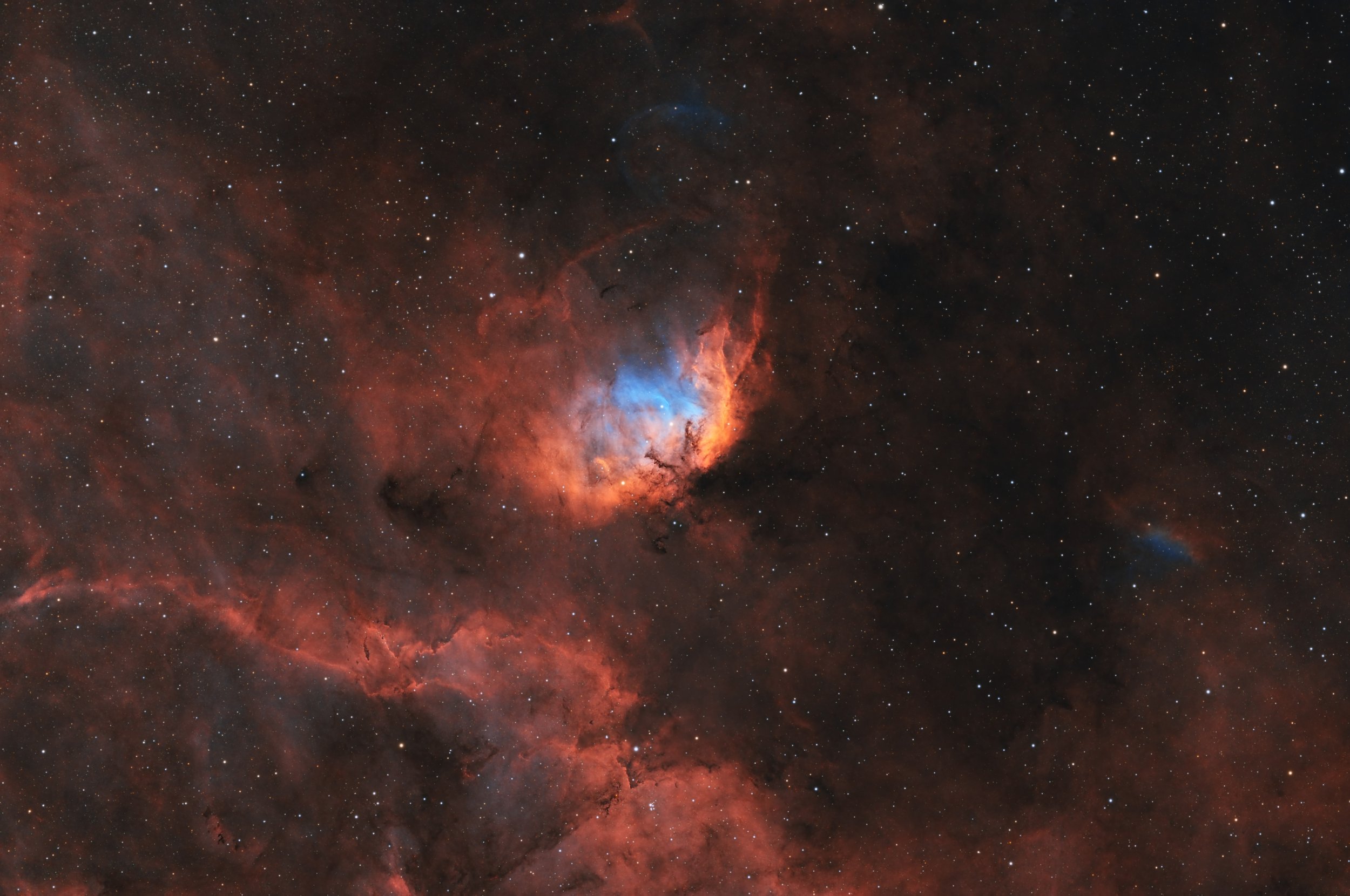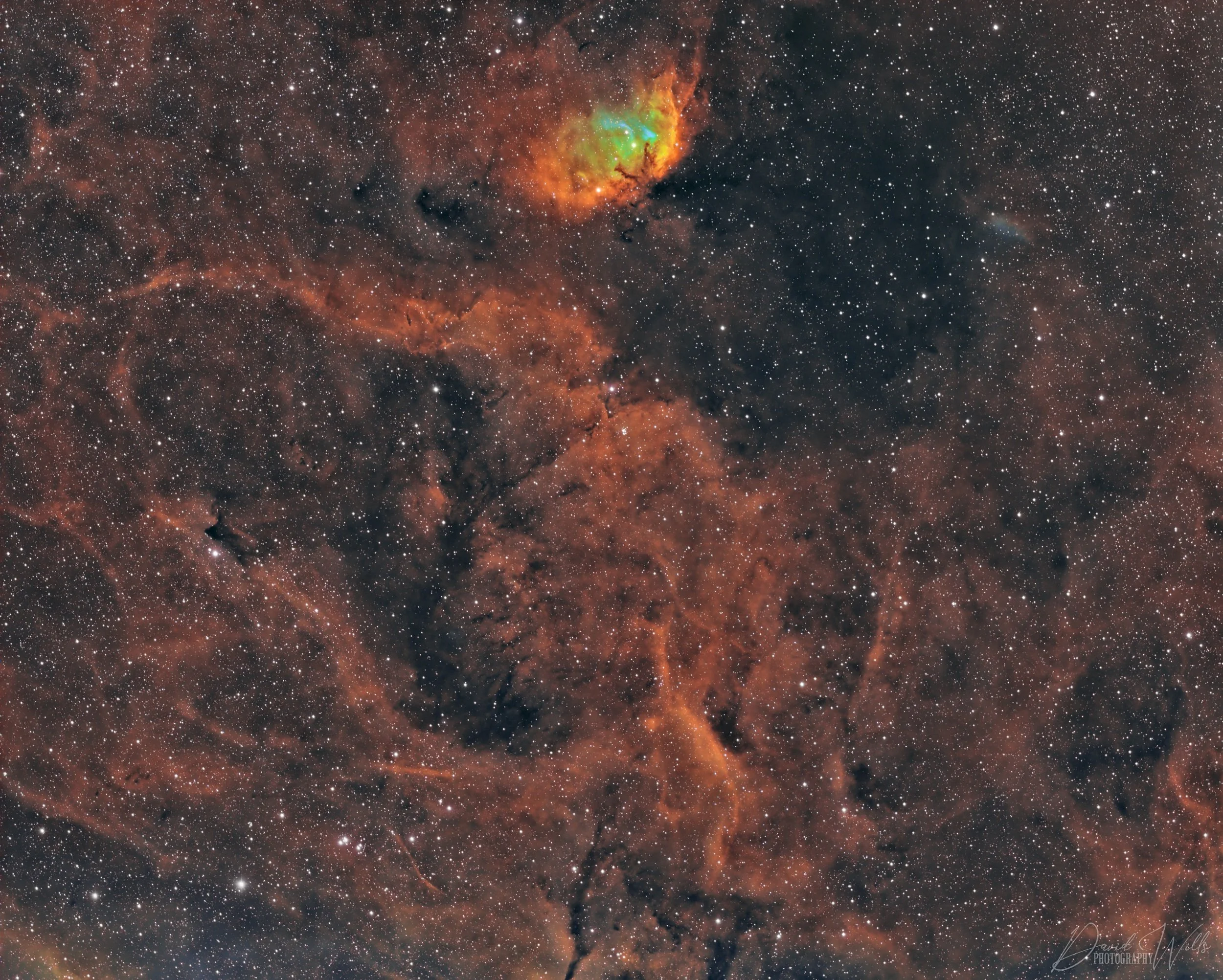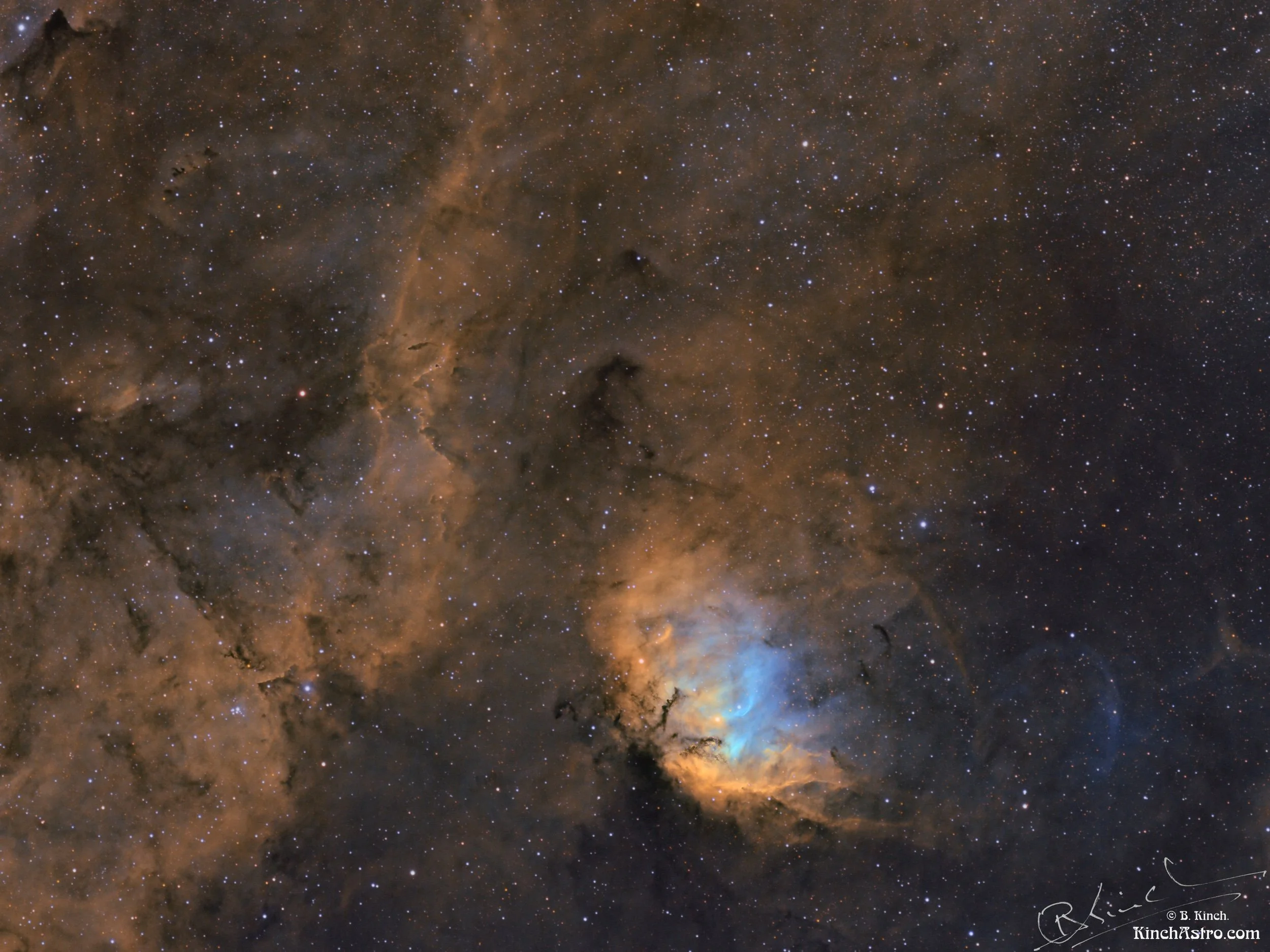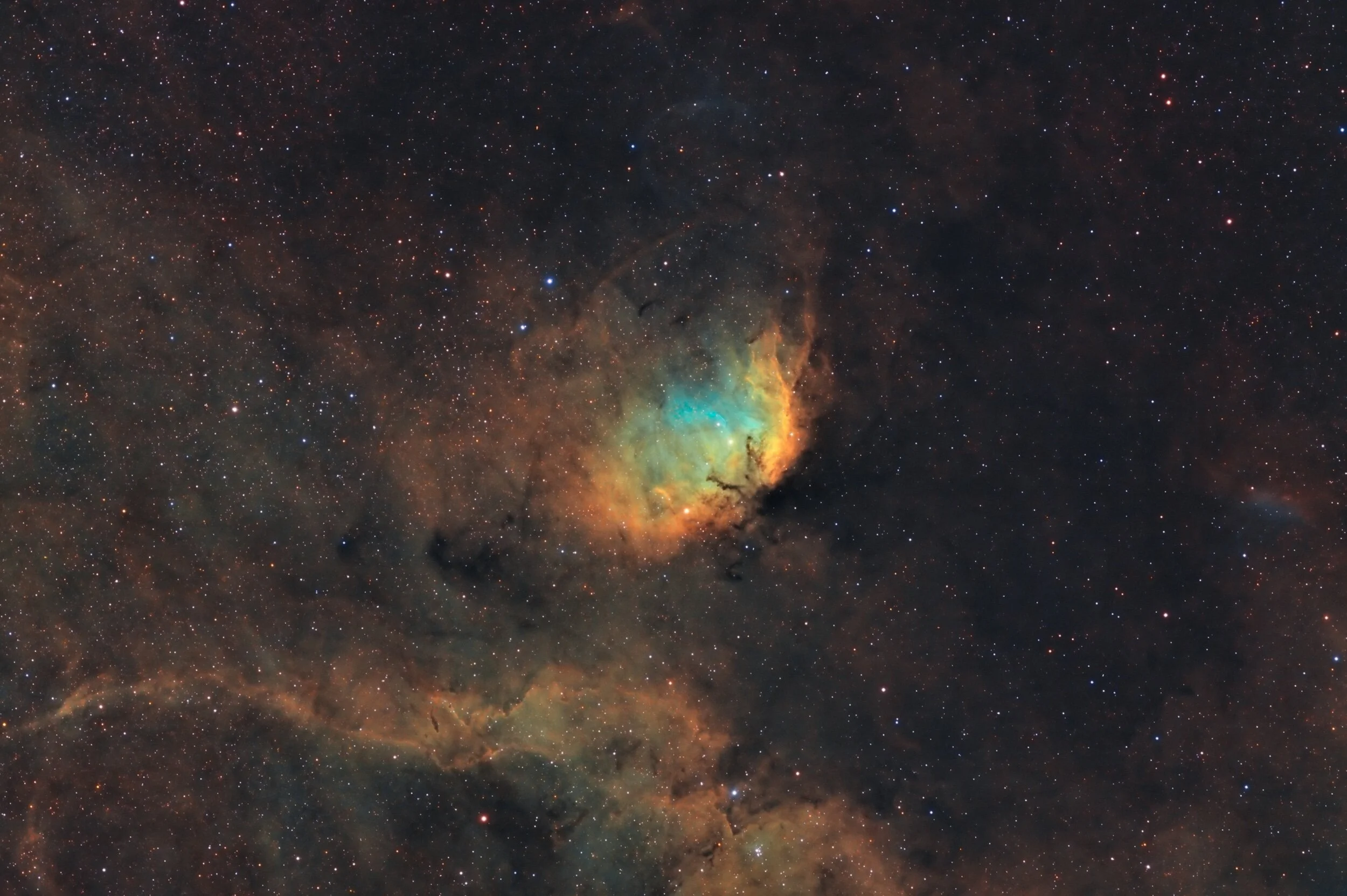
AAPOD2 Image Archives
SH2-101 Tulip Nebula
In this striking narrowband image captured in the Hubble Palette, Sh2-101, also known as the Tulip Nebula, unveils its cosmic beauty in vivid and ethereal colors. Nestled in the constellation Cygnus and situated approximately 6,000 light-years away from Earth, the Tulip Nebula showcases its intricate structure in a palette that emphasizes specific emissions from hydrogen, sulfur, and oxygen gases.
The image reveals the petals of the Tulip Nebula, with vibrant shades of red, green, and blue, created by the interplay of these elemental gases under the intense radiation of nearby stars. This cosmic scene, presented in the Hubble Palette, serves as a testament to the remarkable beauty and complexity of the universe, where the celestial canvas is painted with the brushstrokes of light, matter, and cosmic forces.
SH2-101 - The Tulip Nebula
Image Description and Details : SH2-101 - The Tulip Nebula. Located 6,000 light years away in the constellation Cygnus.
Celestron 11” Edge HD with .7x reducer at F/7
Celestron OAG and a ZWO 174mm guide camera
Ioptron CEM 70 mount
ZWO 2600MM Pro cooled to -10° / gain 100.
ZWO ASIAIR pro+
ZWO EAF focuser
Chroma 3nm filters with ZWO 7x36mm EFW
Processed in Pixinsight.
Shot from my backyard, bortle 8.
Ha - 5 min subs x 64= 5.33 hrs.
Oiii - 5 min subs x 61 = 5.08 hrs.
Sii - 5 min subs x 63 = 5.25 hrs
Total integration time = 15.66 hrs.
Copyright: Richard McInnis
LBN168 Tulip Nebula
Image Description and Details : Tulip Nebula captured by David Wills at PixelSkies, Castillejar, Spain Ha 80 x 300s OIII 80 x 300s SII 105 x 300s 22 hrs 5 mins in total. Equipment used: Telescope: Takahashi Baby Q FSQ-85ED F3.9 Camera: Xpress Trius SX-694 Pro Mono Cooled to -10C Image Scale: 2.08 Guiding: OAG Filters: Astronomik Ha,OIII,SII Mount: iOptron CEM60 "Standard" GOTO Centre Balanced Equatorial Mount Image Acquisition: Voyager Observatory control: Lunatico Dragonfly Stacking and Calibrating: Pixinsight Processing: Pixinsight 1.8, Photoshop CC
Copyright: David Wills
Sh2-101
Image Description and Details : Sharpless 101 (Sh2-101) is a H II region emission nebula located in the constellation Cygnus. It is sometimes also called the Tulip Nebula because it appears to resemble the outline of a tulip when imaged photographically. It was catalogued by astronomer Stewart Sharpless in his 1959 catalogue of nebulae. It lies at a distance of about 6,000 light-years (5.7×1016 km; 3.5×1016 mi) from Earth.
Sh2-101, at least in the field seen from Earth, is in close proximity to microquasar Cygnus X-1, site of one of the first suspected black holes. Cygnus X-1. The companion star of Cygnus X-1 is a spectral class O9.7 Iab supergiant with a mass of 21 solar masses and 20 times the radius of the Sun. The period of the binary system is 5.8 days and the pair is separated by 0.2 astronomical units. The black hole has a mass of 15 solar masses and a Schwarzschild radius of 45 km. A bowshock is created by a jet of energetic particles from the black hole as they interact with the interstellar medium can be seen as an arc (bluish) to the right of the "Tulip".
Imaging telescope: Takahashi FSQ130ED
Imaging camera: ASI 2600MM
Mount: Takahashi EM 400 Temma 2M
Guiding telescope: Takahashi FS60CB
Guiding camera: QHY CCD QHY 5 II
Focal Extender / Reducer: None
Capture Software: Sequence Generator Pro, PHD 2
Processing Software: Astro Pixel Processor, PixInsight, Topaz DeNoise, Photoshop
Filters (50mm): Astrodon Ha (3nm), Astrodon SII (3nm) & Astrodon OIII (3nm)
Accessories: SeleTEK2 controlling Robofocus Focuser, ATIK EFW3
Dates: 29th May 2022
Frames:
Astrodon Ha 9 x 10'
Astrodon SII 9 x 10'
Astrodon OIII 9 x 10'
Total integration = 4 Hours 30 Mins
Copyright: Brendan Kinch
The Tulip
Image Description and Details : This colourful region, located in the constellation Cygnus, has many distinct views of energized gas, all of which give a deep sense of wonder and amazement. The night sky is wonderful, always look up!
We are star dust.
——————
This was captured over 8 nights across June and July, only 3 hours at a time due to our limited darkness on the 51st parallel North.
27hr 47min total exposure time
94x300” Sii
84x300” Ha
119x300” Oiii
31x120” R
32x120” G
28xx120” B
40x Darks
180 Flats/Dark Flats
06/06, 06/25-30, 07/09/2021
Bortle 6/7
Calgary, AB
Setup#1 - SHO
711mm Focal Length
@williamoptics GT102
@williamoptics Flat68iii
@antliafilters SHO 3nm, 2”
@antliafilters RGB, 2”
@skywatcherusa EQ6-R Pro
@zwoasi ASI2600MM-Pro, unity, -10C
@zwoasi EAF
@zwoasi EFW 7x2, 2”
@zwoasi OAG68M
@zwoasi ASI290MM-mini
@zwoasi ASIAir Pro
APP, PI, PS, MLR
Copyright: Andrew Lesser
SH2-101 Tulip Nebula
Image Description and Details :
A real challenge! Through the smoke of Canadian forest fires, during a full moon and under a Bortle 9 sky, I took this picture of the Tulip Nebula (SH2-101) with about 10 hours of exposure in SHO from Montreal. I struggled with the processing, especially to bring out the weak OIII signal…
Interesting thing here, we can see the Cygnus X-1 binary system (above the Tulip nebula on the picture). It is a high mass X-ray binary system, it is a galactic source of X-rays. It was the first source of this type to be considered as a black hole.
TSA102
CEM70
Chroma 3nm filters
QHY294M
Copyright: Jonathan Durand
Crescent and Tulip Nebulae Wide field
Image Description and Details : Widefield image of a nebula-dense region in the constellation Cygnus. The image contains the crescent nebula in the top right and the tulip nebula in the lower left.
OIII: 120x300" (10h) bin 1x1
Hɑ: 135x300" (11h 15') bin 1x1
SII: 106x300" (8h 50') bin 1x1
Gain: 111.00; -15C
Total Integration: 30h
Camera: ZWO 183MM Pro
Lens: Rokinon 135 f/2
Mount: Sky-Watcher EQ6R Pro
Copyright: Frank Turina
Tulip nebula & Cygnus X-1 black hole jet
Image Description and Details :
Next to the tulip nebula is black hole Cygnus X-1. This is the first X-ray source discovered in Cygnus and the first black hole ever confirmed. The blue star HD 226868 revolves around this black hole in 5.5 days.
The black hole draws in gas from this star. The gas that piles up in the accretion disk around the black hole becomes so hot that it emits X-rays. In addition, the infalling gas also forms a jet.
This jet collides with the interstellar gas. The shock wave that this forms can be seen in this image.
Details:
telescope: Skywatcher 150/750PDS
mount: Skywatgcher HEQ5
camera: QHY 294M
filter: Astronomik 12nm Ha
74 x 6 minutes (7.4 hours) over 2 nights
40x flat and darkflat frames
30x dark frames
image aquisition: NINA
processing: Pixinsight.
Copyright: Remco Kemperman
cygnus mosaic
I have started this imaging project back at 2010. My aim was to make a high resolution mosaic covering the constellation Cygnus. Work like that takes time and patience, especially since I have worked so, that many of the individual sub mosaics or frames have been published as an individual artworks. Here is a poster format presentation about all of longer focal length images used for this mosaic beside wide field panels.
As a result I have now a huge 37 panel (And 58 long focal length sub-panel) mosaic panorama covering 28 x 18 degrees of sky. I have collected photons way over 600 hours during past ten years for this photo. The full size mosaic image has a size of about 25.000 x 15.000 pixels.
In the orientation image above, there are three large supernova remnants visible, first the Cygnus Shell W63 , bluish ring at upper left quarter, secondly the large SNR G65.3+5.7 at utmost right and finally the third is a brighter SNR, the Veil nebula just outside of field of view at bottom center. (Image is partly overlapping with large mosaic but I didn't want to include it yet due to artistic composition.)Beside three supernova remnants there are two Wolf Rayet stars with outer shell formations. NGC 6888, the Crescent Nebula at center of the image and the WR 134, it can be seen as a blue arch just right from the Crescent Nebula, near the Tulip nebula.Next to the Tulip Nebula lays a Black hole Cygnus X-1, it's marked in small closeup image of the Tulip Neula at center right in orientation image above.
There are 37 base panels with shorter focal length tools (300mm f2.8 Tokina and 200mm f1.8 Canon) There is also 59 sub-panels used, they are shot with my old 12" Meade and 11" Celestron Edge scopes.
Copyright: J-p Metsavainio
The Tulip Nebula Sh2-101
Image Description and Details:In a constellation rich in nebulae such as the Swan, there is an object commonly called the Tulip nebula. An incandescent cloud of interstellar gas and dust cataloged in 1959 by the astronomer Stewart Sharpless as Sh2-101.About 8,000 light years away from Earth, the ultraviolet radiation from the young stars on the edge of the Cygnus OB3 association ionizes and feeds the emissions of the Tulip Nebula.Near the center of the nebula there is a very bright star called HDE 227018, while in the upper right you can see an arch originating from Cygnus X-1, a microquasar, and from the star with which it shares a binary system. This is one of the most intense X-ray sources measurable from Earth, probably attributable to the presence of a black hole. Cygnus X-1 was in fact at the center of a bet between physicists Stephen Hawking and Kip Thorne, on the presence or absence of a black hole and ended in the 90s when the data reinforced the hypothesis of its existence.Shooting DataTulip Nebula Sh2-101 | Hubble Palette SHOSii 49x300'' | Ha 77x300'' | Oiii 56x300''Sky-Watcher 200/800 f/4 | AZEQ6-GT | QHY 163M | Optolong narrowband FiltersFrames captured between 26/29th of Jun 2020 from Carl Sagan Observatory in Maranello (Italy).Bortle 5 / SQM 19.65
COPYRIGHT: Luca Fornaciari










